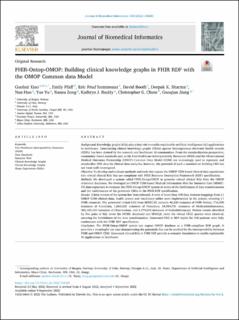| dc.description.abstract | Background
Knowledge graphs (KGs) play a key role to enable explainable artificial intelligence (AI) applications in healthcare. Constructing clinical knowledge graphs (CKGs) against heterogeneous electronic health records (EHRs) has been desired by the research and healthcare AI communities. From the standardization perspective, community-based standards such as the Fast Healthcare Interoperability Resources (FHIR) and the Observational Medical Outcomes Partnership (OMOP) Common Data Model (CDM) are increasingly used to represent and standardize EHR data for clinical data analytics, however, the potential of such a standard on building CKG has not been well investigated.
Objective
To develop and evaluate methods and tools that expose the OMOP CDM-based clinical data repositories into virtual clinical KGs that are compliant with FHIR Resource Description Framework (RDF) specification.
Methods
We developed a system called FHIR-Ontop-OMOP to generate virtual clinical KGs from the OMOP relational databases. We leveraged an OMOP CDM-based Medical Information Mart for Intensive Care (MIMIC-III) data repository to evaluate the FHIR-Ontop-OMOP system in terms of the faithfulness of data transformation and the conformance of the generated CKGs to the FHIR RDF specification.
Results
A beta version of the system has been released. A total of more than 100 data element mappings from 11 OMOP CDM clinical data, health system and vocabulary tables were implemented in the system, covering 11 FHIR resources. The generated virtual CKG from MIMIC-III contains 46,520 instances of FHIR Patient, 716,595 instances of Condition, 1,063,525 instances of Procedure, 24,934,751 instances of MedicationStatement, 365,181,104 instances of Observations, and 4,779,672 instances of CodeableConcept. Patient counts identified by five pairs of SQL (over the MIMIC database) and SPARQL (over the virtual CKG) queries were identical, ensuring the faithfulness of the data transformation. Generated CKG in RDF triples for 100 patients were fully conformant with the FHIR RDF specification.
Conclusion
The FHIR-Ontop-OMOP system can expose OMOP database as a FHIR-compliant RDF graph. It provides a meaningful use case demonstrating the potentials that can be enabled by the interoperability between FHIR and OMOP CDM. Generated clinical KGs in FHIR RDF provide a semantic foundation to enable explainable AI applications in healthcare. | en_US |

